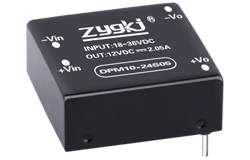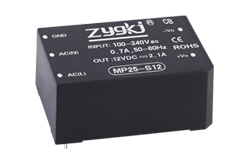nyheder
Bidirectional DC-DC Converter: Efficient Power Conversion in Both Directions
Author: ZYG Power Module Time: 2023-7-1
Introduction
In recent years, there has been a significant increase in the demand for bidirectional power conversion systems. These systems allow power to flow in both directions, enabling efficient energy transfer between different sources and loads. One crucial component of such systems is the bidirectional DC-DC converter. This article will delve into the working principle and advantages of the bidirectional DC-DC converter, highlighting its role in achieving efficient power conversion.
Working Principle
A bidirectional DC-DC converter is a power electronic device that converts direct current from one voltage level to another, while also allowing power flow in both directions. It consists of two main parts: an input stage and an output stage. The input stage typically consists of an active rectifier, which rectifies the input voltage, and a boost converter, which steps up the voltage as required. The output stage comprises a buck converter, which steps down the voltage, and an inverter, which converts DC to AC if needed.
When power flows from the input to the output, the active rectifier and the boost converter work together to increase the voltage level. This configuration allows efficient power transfer from a lower voltage source to a higher voltage load. On the other hand, when power needs to flow from the output to the input, the buck converter and the inverter step down the voltage and convert it to AC if necessary. This bidirectional capability makes the converter suitable for various applications, such as energy storage systems, electric vehicles, and renewable energy integration.
Advantages of Bidirectional DC-DC Converter
1. Energy Efficiency: Bidirectional DC-DC converters offer high energy efficiency due to their ability to transfer power in both directions. By facilitating bidirectional power flow, these converters minimize energy losses and ensure optimal utilization of the available power sources.
2. Power Flow Control: The bidirectional DC-DC converter provides effective control over the power flow direction and magnitude. This feature is particularly useful in applications where power needs to be transferred bidirectionally, such as in energy storage systems. The converter allows seamless switching between charging and discharging modes, ensuring efficient energy management.

3. Voltage Regulation: Bidirectional DC-DC converters enable voltage regulation in systems with different voltage levels. They can step up or step down the voltage as required, allowing compatibility between various sources and loads. This flexibility makes them ideal for integration with renewable energy sources, where voltage levels can vary significantly.
4. Improved System Reliability: By providing bidirectional power transfer, the converter enhances system reliability. It allows for redundancy in power sources, ensuring uninterrupted power supply even in the event of a failure or fluctuation in one source. This feature is especially critical in applications where a reliable power supply is essential, such as in healthcare or critical infrastructure.
Conclusion
The bidirectional DC-DC converter plays a vital role in achieving efficient power conversion in both directions. Its ability to transfer power bidirectionally, coupled with its energy efficiency and power flow control capabilities, makes it a crucial component in various applications. As the demand for bidirectional power conversion continues to rise, further research and development in this field can lead to even more advanced and efficient converters, contributing to a sustainable and reliable energy future.
Tidligere: 24V AC to DC Converter: Efficiently Powering Your Devices with Ease
Næste: SP Series: The Ultimate AC DC Converter for Uninterrupted Power Supply
relevant information
-
2023-5-4
Design and Development of an Industrial AC-DC Converter
Introduction Industrial AC-DC converters are essential components in modern power electronics systems. They convert alternating current (AC) power from the grid to direct current (DC) power for use in various industrial applications. The design and development of an efficient industrial AC-DC converter require a thorough understanding of power electronics principles and a careful selection of components to ensure optimal performance. This article discusses the essential steps involved in the design and development of an industrial AC-DC converter. Step 1: Determine the Specifications The first step in the design process is to determine the specifications of the industrial AC-DC converter. The specifications should include the input voltage and frequency, output voltage and current, power rating, and efficiency requirements. These specifications will...
Se detaljer -
2023-6-27
Bi-Directional DC-DC Converter: A Comprehensive Overview
In recent years, the development of renewable energy sources such as wind and solar power has rapidly increased. However, these sources of energy are intermittent and the output varies depending on the weather condition and time of day. This leads to instability in the power grid. To solve this problem, a bi-directional DC-DC converter is used as a key device to transfer power between the renewable energy source and the power grid. The bi-directional DC-DC converter is a power electronic device that converts DC power from one voltage level to another voltage level. It can transfer power bidirectionally, meaning it can transfer power from the source to the load and vice versa. The converter consists of switches, inductors, capacitors, and...
Se detaljer -
2023-6-7
Power Up with the HP Series AC DC Converter
In today's fast-paced world, time is of the essence. We rely on technology to make our lives easier and more efficient. However, the devices we use require a steady flow of power to function properly. This is where the HP Series AC DC Converter comes into play. The HP Series AC DC Converter is a versatile power supply that can convert AC power to DC power, providing a reliable source of power for a variety of devices. Whether you're using a laptop, a printer, or a gaming console, the HP Series AC DC Converter can help you power up and stay connected. One of the key advantages of the HP Series AC DC Converter is its compact size. The converter...
Se detaljer -
2023-6-7
How to Convert 110V AC to 12V DC?
Converting 110V AC to 12V DC is a process that is often necessary when it comes to powering certain electronic devices and appliances. While it may seem like a complicated process, it is actually quite simple and can be done using a few basic tools and materials. In this article, we will go over the steps you need to follow to convert 110V AC to 12V DC. Step 1: Gather Your Materials Before you begin, you will need to gather all the materials you will need for the conversion process. These materials include a step-down transformer, a rectifier, filter capacitor, and voltage regulator. You will also need a soldering iron, solder, wire, and a multimeter. Step 2: Connect the Transformer...
Se detaljer -
2023-6-18
Custom Type Power Series: The Ultimate Guide to Creating Unique and Effective Typography
Typography is a crucial aspect of graphic design. It's the art and technique of arranging type to make written language legible, readable, and appealing when displayed. Custom typography takes it a step further by creating unique and personalized typefaces that reflect the brand 's personality. In this guide, we'll explore the basics of typography, the benefits of custom typography, and the steps to create your own custom typeface. Typography Basics Typography has its own language with terms like serif, sans-serif, kerning, tracking, and leading. Let's break them down: - Serif: A small line or stroke attached to the end of a letter or symbol. - Sans-serif: A typeface that does not have serifs. - Kerning: The process of adjusting the...
Se detaljer -
2023-4-23
Distinguishing Between AC and DC Power Supplies
AC and DC power supplies are two types of electrical power sources commonly used in various applications. AC stands for alternating current, while DC stands for direct current. The main difference between the two is the direction of the flow of electrons through the circuit. In this article, we will discuss the differences between AC and DC power supplies in terms of their characteristics, applications, and advantages. Characteristics of AC Power Supplies: AC power supplies provide electrical power that changes direction periodically. The voltage and current in an AC circuit oscillate sinusoidally, which means that they change direction and magnitude constantly. The frequency of this oscillation is measured in Hertz (Hz) and is typically 50 or 60 Hz in most...
Se detaljer


















